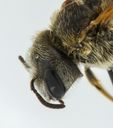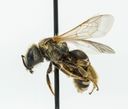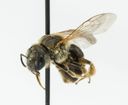Ligated Furrow Bee
Halictus ligatus
Classification
- Phylum: Arthropoda
- Subphylum: Hexapoda
- Class: Insecta
- Order: Hymenoptera
- Family: Halictidae
- Subfamily: Halictinae
- Tribe: Halictini
- Genus: Halictus
- Species: ligatus
Pronunciation
How to pronounce Halictus ligatus: //həˈlɪktəs lɪˈɡeɪtəs//
These audio files are automatically generated. While they are not always 100% accurate, they are a good starting point.
Images






Summary
Halictus ligatus is a widely distributed, primitively eusocial sweat bee known for its diverse nesting behaviors and reproductive roles. It plays a significant role in pollination and exhibits fascinating social structures dependent on environmental factors.
Physical Characteristics
Females measure 8-10 mm, males measure 7-9 mm; have well-defined basal hair bands and relatively broad apical hair bands; females possess a robust head with a genal tooth; males have pale antennae below and pale tegulae.
Identification Tips
Best distinguished from H. poeyi based on range or DNA sequence data, and by the presence of a postero-ventral genal tooth in females and long suberect hairs on the second and third metasomal sterna in males.
Habitat
Nests in level, well-drained, hard-packed soil free of vegetation; commonly found in dense aggregations in dirt roads and paths.
Distribution
Widespread across North America, from southern Canada to the Gulf of Mexico, including temperate areas from the Atlantic to the Pacific, the West Indies, and Colombia.
Diet
Polylectic; bees visit a variety of flowering plants for pollen and nectar; larvae are provisioned with a mass of pollen and nectar.
Life Cycle
Annual lifecycle in temperate regions, involving periods of dormancy; multiple cycles occur in southern Florida, with late summer emergence of gynes and males.
Reproduction
Exhibits primitive eusociality, with a reproductive division of labor; queens (foundresses) often have larger body sizes and energy reserves, while workers may assist in brood care or reproduce.
Ecosystem Role
Important pollinators for various flowering plants; can influence local plant community dynamics through their foraging activities.
Collecting Methods
- Netting
- Trapping
- Visual observation
- Baiting with floral resources
Preservation Methods
- Ethanol fixation
- Slide mounting
- Pinning
Evolution
Part of a species complex, with genetic differentiation influencing behavior and social structure; closely related species like H. poeyi have been recognized based on mitochondrial DNA analysis.
Similar Taxa
Misconceptions
Often confused with other sweat bees due to overlapping ranges and similar physical characteristics.
Tags
- sweat bee
- Halictidae
- pollinator
- North America
- eusocial